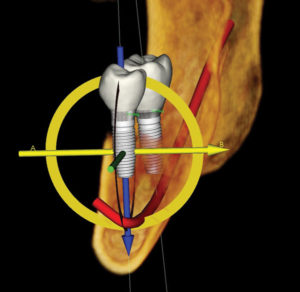By Patrick L. McGee, DDS

There are no surprises when the anatomy is seen in 3D prior to planning and treatment.
When learning about implants during my residency, 3D imaging was a significant part of the evaluation and planning process. 3D scans allow for measurements that facilitate precision. With this information, I can avoid possible complications by gaining anatomical information that may not be determined from a 2D X-ray. With 3D imaging, I don’t have to guess, estimate, or be surprised by patients’ anatomical anomalies.
I knew the advantages of 3D imaging but was not sure which brand would best suit my practice. Thankfully, I already knew my Henry Schein Dental representative, Scott Rogers, would be very helpful regardless of whether I was interested in a large item, like a 3D unit, or something as small as impression material. Scott contacted Ty Ramsey, a knowledgeable i-CAT™ representative and set up a webinar. Ty’s presentation was so informative I quickly realized I wanted to have the capabilities of this brand for my patients’ care.
The i-CAT FLX V-Series offers three maximum fields of view and is upgradable. Ultimately, I chose the V10 with its 10 cm. x 16 cm. field of view. It was a good fit for my present implant-focused practice and future aspirations, which include the expansion into TMJ and airway evaluations. All of the units include a dedicated 2D pan. Within the planning software, I can virtually place implants in their proper position and utilize surgical guide technology.
Another plus is that patients understand their conditions more clearly when I can explain and show them their anatomy in 3D. I have noticed it motivates them to make better choices regarding their treatment. They realize I have invested in a technology that leads to more precise procedures, and this has translated into more referrals and having a reputation as a technology-savvy practice.
Over 25 years, the company has developed a worldwide, award-winning reputation for development and manufacturing of dental radiography products, and their CBCT units are made in the USA. Their strong focus on 3D education includes webinars, customer trainings, and clinician-led live events to help owners get the most from 3D technologies.
3D imaging, in my experience, is a confidence- and practice-building imaging modality. I encourage my colleagues to check out the features of the units, view the history and reputation of the manufacturer, and choose a unit that is right for your practice. Just as you would want to make important decisions by knowing all of the facts, you should base your clinical diagnostics and treatment on the patient’s anatomical “facts”— 3D can make that happen. Indications for use: www.i-cat.com/ifu
About the Author: Dr. McGee studied at Louisiana Tech University and earned his Doctorate of Dental Surgery from the Louisiana State University School of Dentistry. He then completed a dental implant residency program in Bessemer, Alabama. Dr. McGee also has completed training in IV sedation, dental implants and bone grafting surgery, Invisalign®, and Six Month Smiles®. He has special interests in dental implantology, oral pathology and management of oral diseases, TMJ disorders and orofacial pain. Dr. McGee maintains memberships in the American Dental Association, Louisiana Dental Association, Academy of General Dentistry, American Academy of Implant Dentistry, Academy of Osseointegration, and International College of Oral Implantologists. Dr. McGee has no financial interests in i-CAT or KaVo Kerr.
